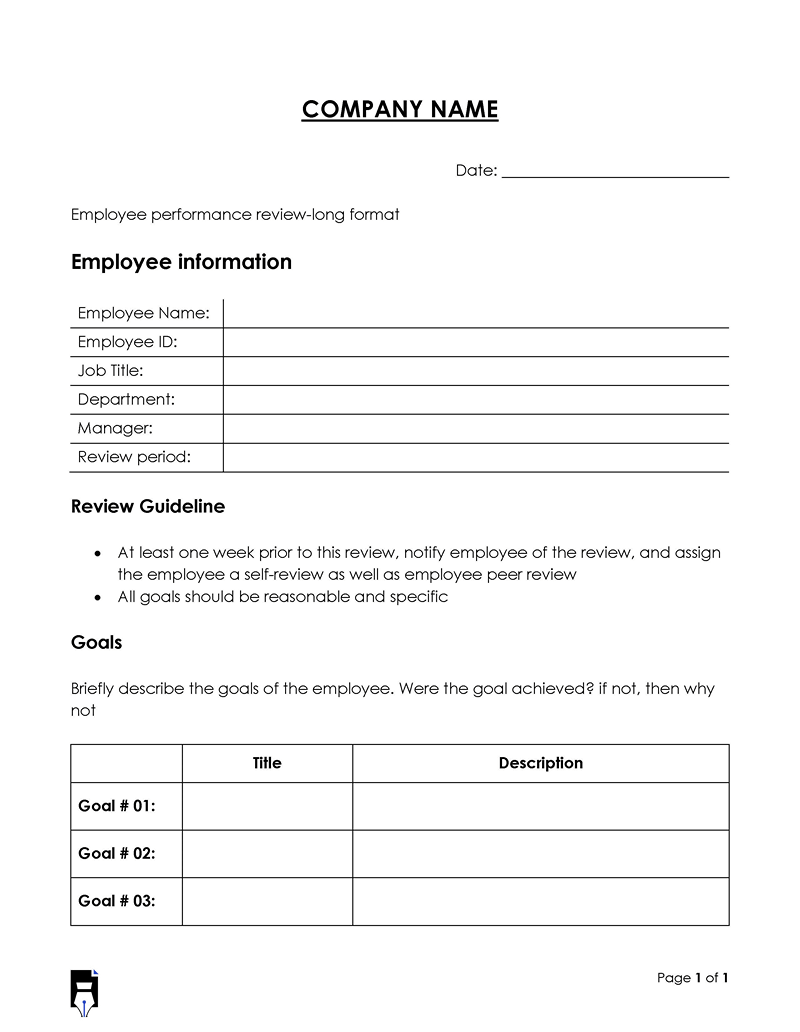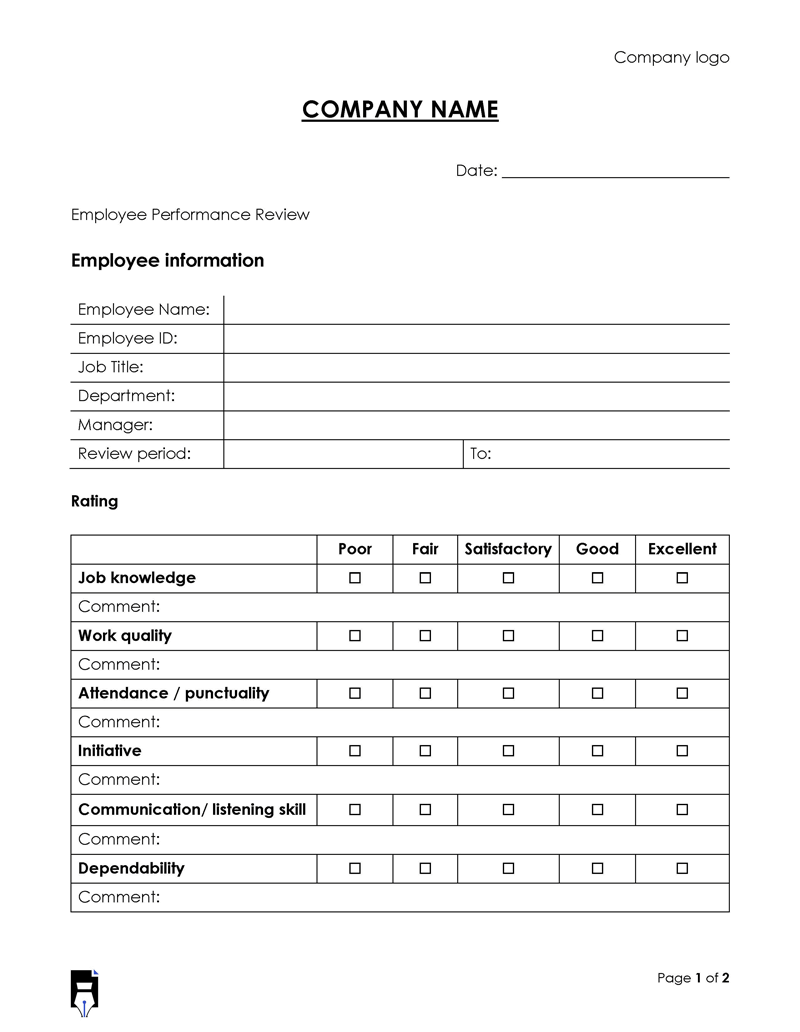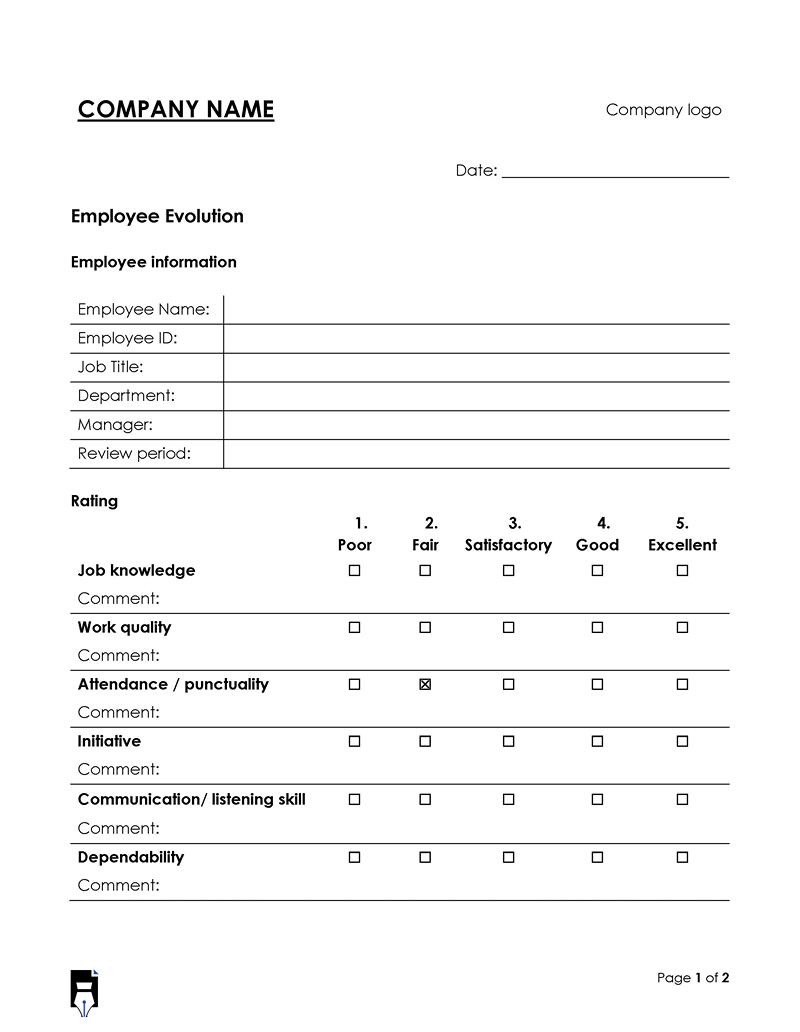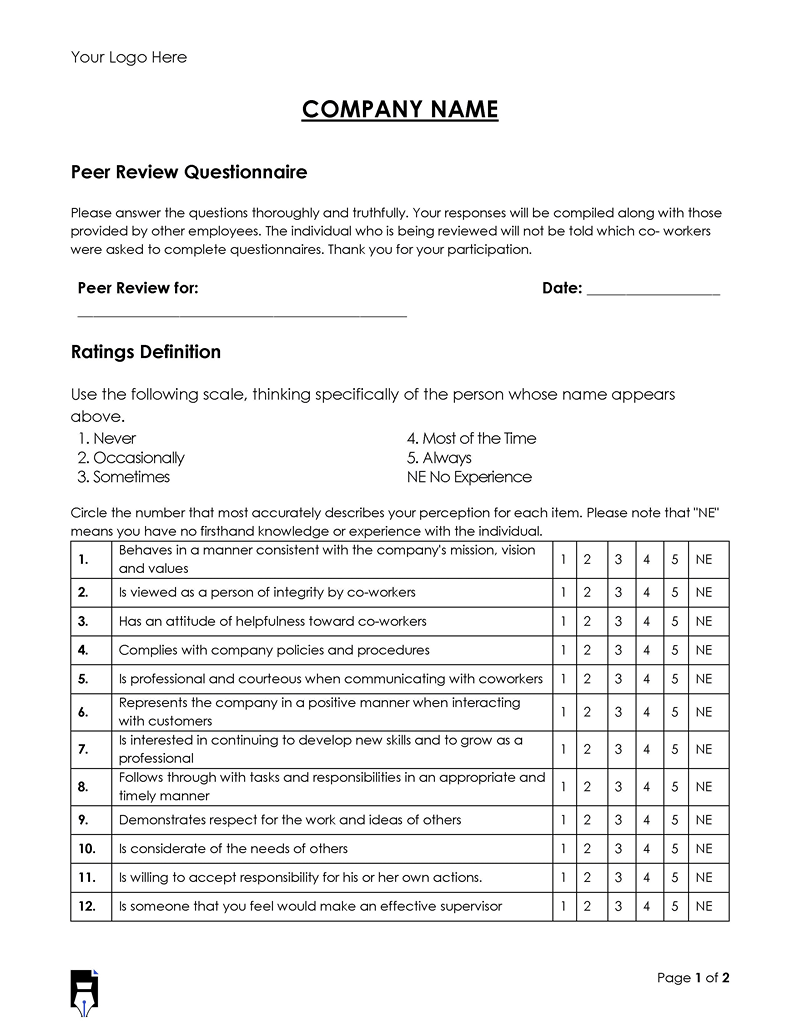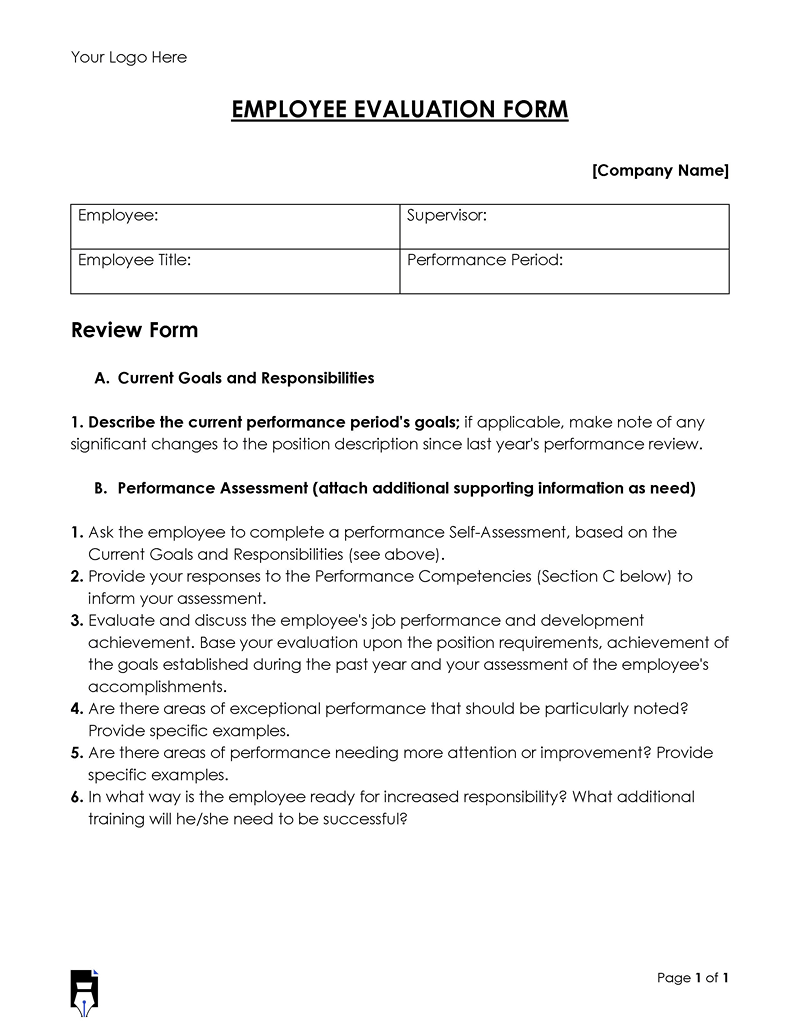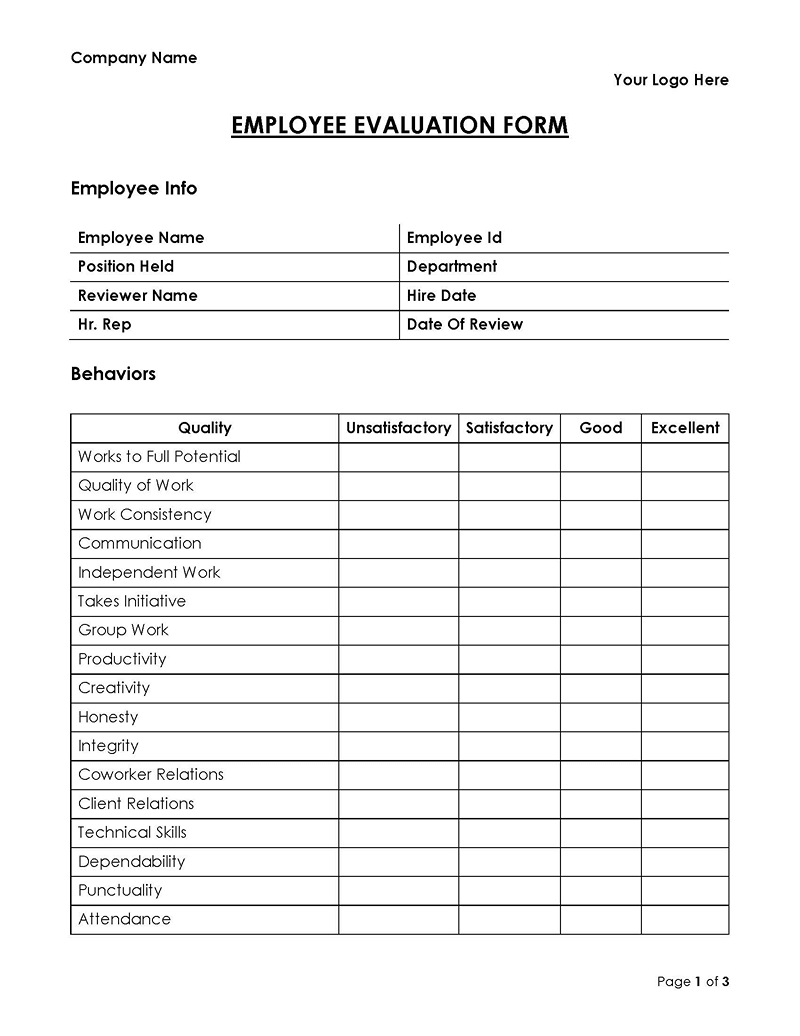In any organization, employees must understand how their individual performance compares to their employer’s expectations. This is critical for successfully running any business. Their employer must evaluate them regularly to ensure that their conduct is excellent. Regular assessments, which may take numerous forms based on the needs and size of the company, are one of the most significant ways to achieve this. However, an employee evaluation form is the most productive approach to conducting performance reviews.
The hiring department can then use such feedback to promote staff or issue incentives. They can also be used to log misconduct by a worker that may warrant termination. The form can be used as proof if they seek legal counsel to challenge their termination.
In this article, we will define an employee evaluation form and what to include in it. It will also guide you on how to conduct it successfully. If you have many employees across different departments, free downloadable templates have also been provided to ease the creation process.
Statistical Insight: Evaluations are a source of anxiety among employees. Human resource professionals say 18% to 25% of them cry during yearly evaluations. A disproportionate performance evaluation is responsible for them quitting their jobs.
Employee Evaluation Templates
You can download the following employee evaluation templates for free:
What is Employee Evaluation Form
An evaluation form is a sheet used by an employer to review the performance of their staff. These forms enable organizations to identify their strengths and shortcomings.
It is typically used to assess their work quality in relation to their abilities, experience, or qualities. Moreover, it compels employers to highlight areas of weakness, allowing them to plan for improvement through further training or additional recruitment.
There is no specific approach to creating the form. Utilizing a template is very beneficial. You may also use word processing programs such as Microsoft Word, Microsoft Excel, or Google Docs. To avoid bias, your form should incorporate a consistent grading system for every employee. The form serves as a reminder for them to focus on the organization’s aims and objectives. It can also help ascertain which ones to reward with promotions or incentives such as bonuses and raises. Evaluations are generally done regularly, such as once or twice a year.
Statistical Insight: Many people think that employee evaluations should be eradicated. Even though large corporations have eliminated these assessments, 69% of companies still assess their staff annually or semi-annually in one form or another.
Proper Way to Format an Employee Evaluation Form
The form is merely a checklist of the criteria you aim to assess and timelines to be observed to achieve the best possible evaluation results. It must be simple to interpret, easy to follow, and contains every detail the assessment process may entail. It usually has the employee’s name, ID, designation, and department. The review period and details of the individual conducting the evaluation are also included.
It uses a rating system in various pre-defined categories, generally on a scale of 1-10 or 1-5, followed by short remarks. Finally, it has an area for general comments and steps you shall implement to increase productivity. The assessor usually signs the evaluation form to authenticate it.
A minimalist approach is ideal because it uses only one color and keeps all the content on one page. Each evaluation criteria should have its own field with checkboxes in a table-like format. Use the same font throughout the form to ensure a consistent and professional appearance. The preferred font and font size is Times New Roman 12. However, other commonly used fonts such as Arial, Calibri, or Helvetica may be suitable. To give it a polished appearance, use standard 1-inch margins and single spacing.
What to Include in Employee Evaluation Form
The structure of the form will depend solely on the organization’s guidelines and the information required.
It generally includes the following components:
Employee and reviewer information
The first element should be the personal details of the employee being assessed. These may include their name, identification number, designation, supervisor, and employment period, among other details. These details should be followed by information on the person actively conducting the assessment. You may include their name and title, for example, hiring manager, supervisor, or director. For better presentation, this information should be tabulated.
Review period
Include the date the evaluation is being carried out on and for which period. This aids in analyzing the progress attained by the employee since the previous assessment.
Most reviews are conducted annually but may be undertaken semi-annually or quarterly, depending on an organization’s policies.
Rating system
The rating system is the most crucial element of the evaluation form. Select a rating system that is easy to understand. Thanks to rating systems, staff members understand why they are awarded a particular score. The 1-5 and 1-10 rating systems are most commonly utilized.
For example:
if you choose a 1-5 rating system, you may grade it as shown below:
1 – Poor
2 – Fair
3 – Satisfactory
4 – Good
5 – Excellent
However, yes or no questions may also enable you to assess an employee’s disposition rather than analyzing their specific performance in that position.
Evaluation points
During the process, evaluation points form the essence of the appraisal. The employee’s performance is assessed according to several criteria, such as:
1. Job knowledge
This is one of the crucial parts of the evaluation since an employee’s knowledge about their job directly impacts the organization’s overall performance. To evaluate their knowledge about their duties, assess whether they:
- exhibit an acceptable degree of knowledge about their unique role,
- have the requisite technical, managerial, or professional skills to perform effectively, or
- are ready to learn more about their job.
2. Work quality
Work quality is associated with craftsmanship and competence and is crucial when evaluating performance. Determine whether the work produced by the staff member over the period met the standards set by your organization. Additionally, appraise whether every detail was considered and identify any mistakes they made.
3. Punctuality/Attendance
To evaluate the employee’s punctuality, you may refer to their timesheet to get accurate information on their attendance. To assess their punctuality, determine whether they:
- report to duty on time,
- clock out as required, or
- spend sufficient time on tasks.
4. Initiative
No matter the size of your organization, an employee who takes the initiative contributes to your overall success. To review how they perform their duties and pursue company objectives, identify whether they:
- take the initiative to achieve their goals,
- need to be pushed to excel,
- display a willingness to take on additional challenges or obligations, or
- express a desire to thrive at their job.
5. Communication/Listening skills
Communication is key in any workplace. Analyze how effectively employees communicate their thoughts and ideas about work matters with superiors, coworkers, vendors, customers, and other stakeholders.
Assess how efficiently they:
- listen to other team members,
- take direction and feedback,
- convey their thoughts both in writing and orally.
6. Dependability
Analyze the employee’s adaptability to change. To assess their dependability, consider whether they:
- are open to fresh ideas or changes, or
- show the capacity to alter their working style or procedures.
Consider how they responded to the goals you established with them during the previous assessment and evaluate whether they made the required changes to reach their objectives.
Goals
In this section, the employee is graded based on how well they achieved goals set during the previous evaluation. These should reflect their strengths and be determined in collaboration with them. They should be SMART, i.e., specific, measurable, achievable, realistic, and timely. Additionally, they should indicate their progress and allow for improvement. When assessing, rate them and provide a brief reason for the rating. Finally, present methods to assist them in attaining goals they did not accomplish.
Comments
Have a blank, bordered area for honest remarks, opinions, and improvement suggestions. You can also allow employees to express obstacles that impede them from reaching their full potential.
Verification of review with signature
Signatures are the final section of the form. Both parties affirm that they comprehend the components and method of the evaluation by providing handwritten signatures.
Note: The process outlined above may take time and effort. Download one of our free templates, which are easy to use, customizable, and presentable. They have placeholders that you can readily edit depending on the preferences of your evaluation criteria.
How to Conduct Employee Performance Evaluation
Human resource guidelines of many companies require employee assessments to be conducted in person and with hard copy forms. Before formally conducting the process, you must collect and evaluate relevant documentation about the worker’s productivity and conduct. Review your records as well as their personnel file. Furthermore, examine additional documents, such as sales figures, phone call records, productivity records, timesheets, projections, or budgetary reports.
During the evaluation, consider the following steps to ensure maximum efficiency:
Step 1: Evaluate honestly
Emphasize how well or poorly the employee performs their duties rather than the individual’s traits. For example, do not state they are “rude and distracted.” Instead, concentrate on the problematic characteristic that affects your company’s productivity. For example, you may mention that they “have been disrespectful to management thrice in the last quarter. This unacceptable behavior must be stopped, or termination will be recommended.”
Step 2: Consider legal factors
The questions contained within an evaluation cannot discriminate against any employee. The form might be used as evidence in a lawsuit. If this happens, you will want the court to comprehend why you gave them the rating you did. Should you need to terminate them due to poor performance, you will need a written record of poor performance.
You should also be mindful when giving a low rating to the worker who has filed complaints with your hiring department, which may result in retaliation. Maintaining equity and fairness ensures all employees are subject to the same questions and performance analysis procedures.
Step 3: Conclude and review
To conduct a productive employee evaluation, it is necessary to balance honest criticism with appreciation and praise and create ambitious yet realistic goals to help the company grow. Although striking this balance can be challenging, providing honest and direct input, both positive and negative, can inspire them to improve.
Step 4: Highlight strong and weak points
When rating your employee, clearly specify their areas of strength and weakness and what they must do to improve. For example, do not say “be punctual” or “increase quality.” Instead, write “clock in by 8:30 AM” or “make no more than five data input errors per day.”
Furthermore, when evaluating them, provide particular instances of what they did to meet or fall short of the objective. Give them a timeframe to improve their performance if you want to achieve progress. If you require a deliverable to be achieved at a particular time, specify the date.
Step 5: Discuss the results with the employee
To make the evaluation process fair to your employees, allow them to address their concerns. Ask them what they appreciate most about their careers and working for your organization. Inquire about any issues or challenges they may have. You will gain useful insight from them, and they will feel like they are a part of the process.
Conclusion
To identify weak spots in the workforce, organizations utilize employee evaluation forms. Employers use such information to create objectives and craft innovative strategies to enhance productivity and efficiency. Nonetheless, some companies opt to use it twice or thrice a year. Company guidelines determine the frequency.
You can save time by downloading and editing one of our free templates when conducting several evaluations. The ones provided in this article guarantee that you will include all pertinent information/criteria. By following these guidelines, you will draft a form to ensure improved employee satisfaction and enhanced overall business performance.
